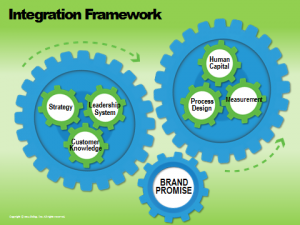Blogrige
The Official Baldrige Blog

Graphic used with permission.
In a previous Blogrige post, we shared insights from Gallup Senior Strategist Dr. John Timmerman on achieving customer-focused excellence. In the interview, Timmerman pointed out that the Baldrige Criteria for Performance Excellence provide “the holistic framework to assess all the dimensions of an organization required for operationalizing their brand promise.”
Now let’s look at how Timmerman has used the Baldrige framework in helping organizations keep the “promise” of their brand in terms of the value perceived by their customers.
In a September 2013 article in Gallup Business Journal, Timmerman states, “To deliver on its brand promise, the first thing a company must do is align all the elements that contribute to an exceptional and differentiated customer experience: customer knowledge, strategy, process design, human capital, measurement, and leadership. These elements are consistent with the well-known Baldrige Criteria for Performance Excellence.”
In the Gallup Business Journal article, Timmerman also writes, “Operationalizing a brand promise isn’t easy and requires an integrated framework to ensure alignment from marketing to each moment of truth.” Users of the Baldrige Criteria know of such a framework, and so does Timmerman.
In an interview for this blog, Timmerman said, “I utilize the principles of the Baldrige framework to outline all the important factors that they need to deliver on their brand promise.” He also noted, “In fact, I went through the Gallup research to develop an Executive Seminar to teach companies to deliver and execute their brand promise—because they create it on paper, but then it’s a very different thing to actually have employees activate it and have it come to light—and when we looked at all our companies’ best practices from the clients that we work with, they all naturally fell into the Baldrige framework.”
Using a vehicle analogy, Timmerman referred to the Baldrige Criteria items related to strategy, leadership, and customer knowledge as the “GPS of the Brand Promise Model” that defines the organizational direction. Whereas the human capital is the engine that delivers organizational horsepower, he said, process design defines the manufacturing style of the vehicle, and measurement provides the dashboard of critical measures.
“Most organizations do a good job of managing a few of these criteria but few execute them all consistently well,” he said. “That’s why many organizations swim in the sea of sameness, have flat customer engagement scores, and struggle with cultural transformation. They take a narrow program and not a holistic, systems view of the organization.”
Timmerman developed a schematic (shown in graphic) using the Baldrige framework “as a way to frame up how to deliver a brand promise.” He noted that clients’ best practices could be put in “buckets” encompassing customer focus, leadership, strategy, human capital, process design, and measurement. With so many organizations trying to implement a customer experience program in a vacuum, he added, the framework illustrates that “all the wheels and sprockets of the model need to be calibrated in delivering a consistent brand promise.”
We hope you find this information helpful to your own organization’s current or future use of the Baldrige framework to improve performance and excel. Please consider sharing your experiences with us.
About the author
Related Posts
Comments
- Reply





